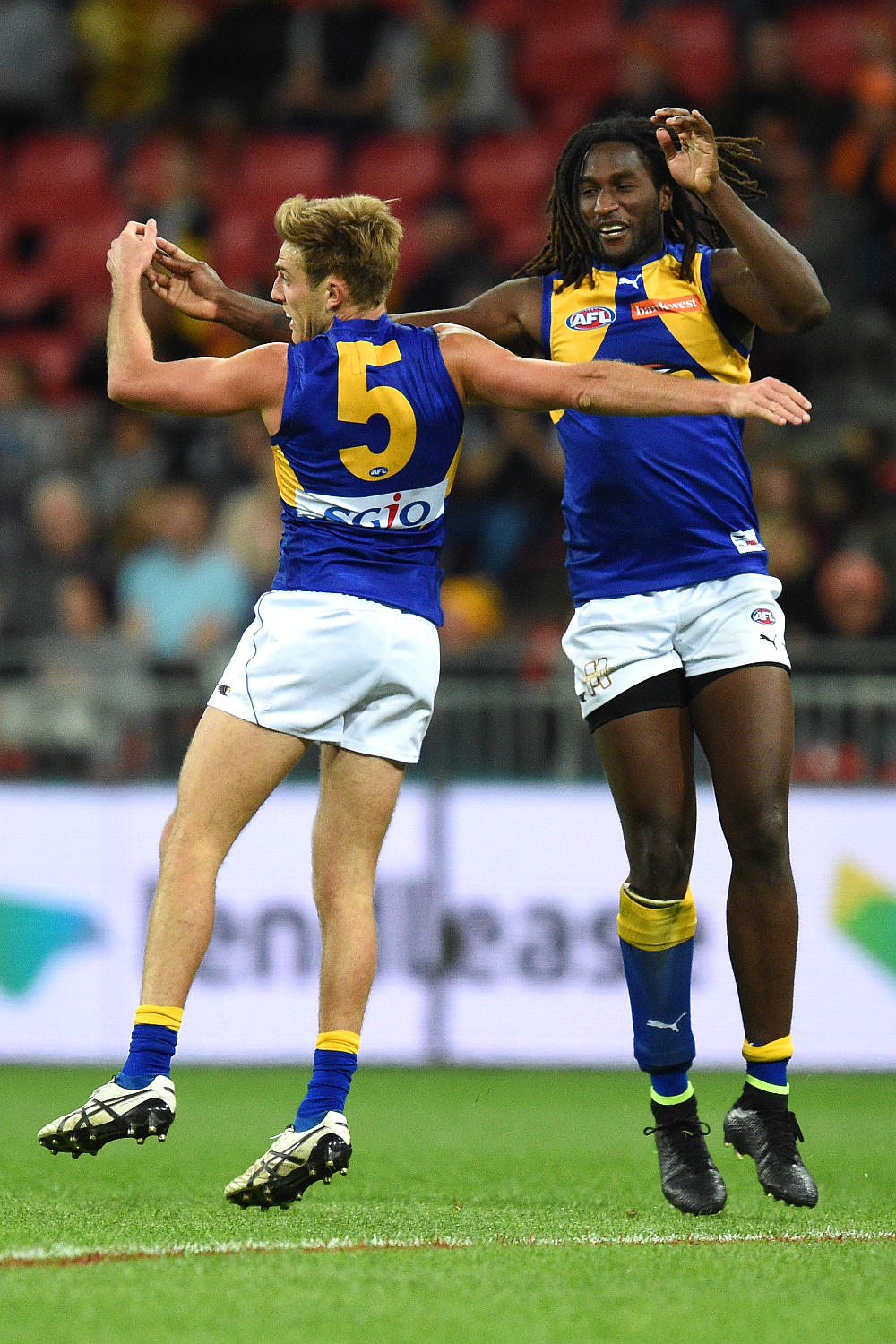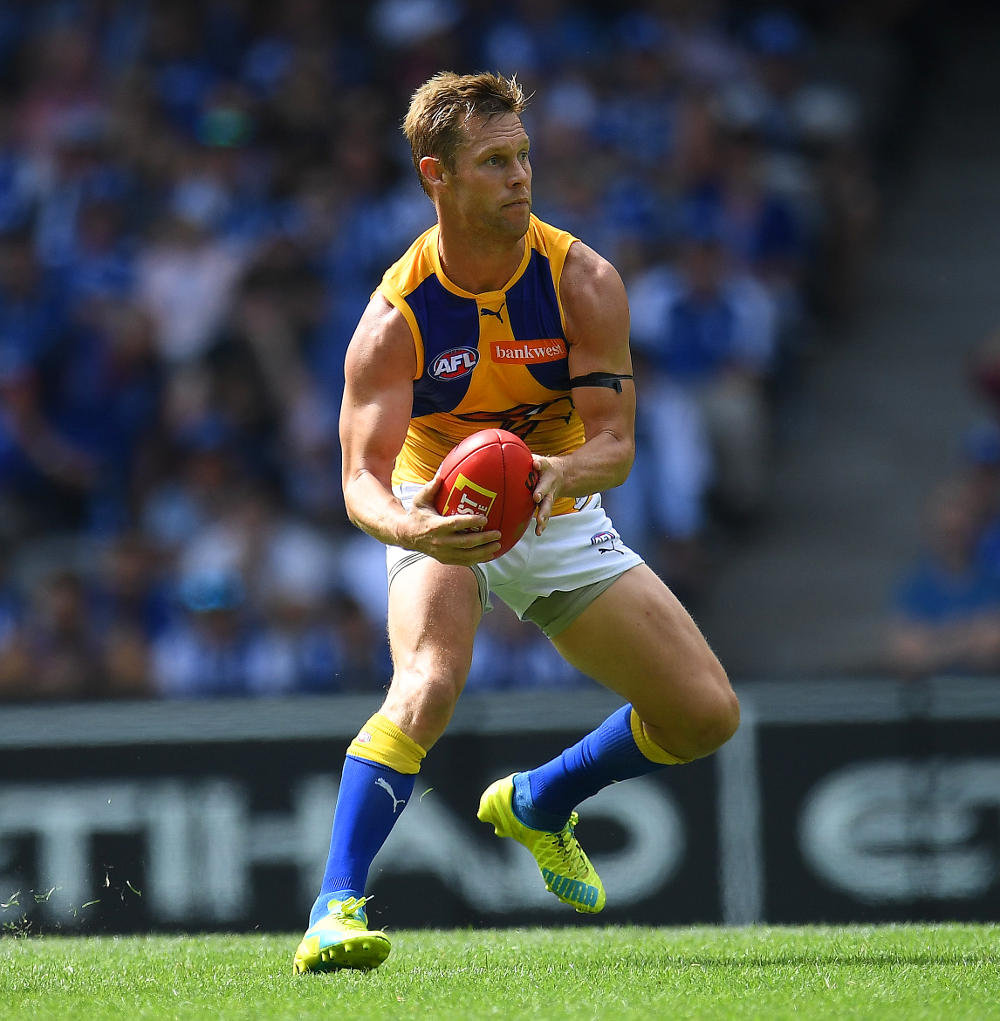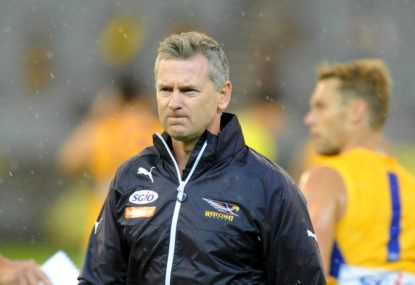The Eagles are built to win more than they lose right now. They are winning more than they are losing – just. It is four minutes to midnight, and West Coast have to win more, and lose less, before it is too late.
West Coast’s comfortable, contending reality was shaken at around 8:15pm on August 19, 2016. Nic Naitanui, the league’s most unique and dominant ruckman, and one of the single most influential players in the competition, landed awkwardly but innocuously on his left knee in a marking contest on the Subiaco Oval turf.
He knew, the crowd knew, the competition knew. Everything changed.
For a player who had been relentlessly criticised as a one-dimensional non-factor for so much of his career, the tide of acknowledgement and respect had finally come all the way in. With it, and with their own freshly minted Alastair Clarkson Coaching Academy graduate Adam Simpson, West Coast graduated from interesting possibility to regular contender.
The tide went out just as quickly. Opting for a traditional knee reconstruction, Naitanui has been touted as a probable 2017 starter for much of the year. A journey to a specialist in the United States, spun as a sign of the extents the Eagles were prepared to go to in order to bring back their superstar, looms as a white flag.
West Coast are a flawed football team. They have been caught flat footed by the league’s pace and space revolution. 2017 is littered with the carcasses of teams that held on a little too long; the Eagles are not there yet, but a growing litany of signs suggest it is one fork in their aspirational road.

AAP Image/Dan Himbrechts
Beware the blue pill
We’ve covered this ground a lot in recent years, but when it comes to West Coast’s prospects it pays to repeat: North Melbourne made a series of defensible moves which resulted in their list falling into disrepair.
The Roos were a good team, full of good to very good players that played football at a good to very good level. After doubling down on their good-to-very-good-ness in 2015 and 2016, North hit the halfway point of last season like a pigeon hitting a plain glass window. It did not end well.
They were forced to awkwardly jettison four celebrated veterans, delist some other players, and pivot to youth. Plenty of teams have done this, but the Roos are doing so from a position of relative weakness – they have no superstar youngster or youngsters in waiting, their middle age players look a lot like 20 possession jobbers, the top end of their list is devoid of experience.
North Melbourne’s rebuild job will be multi-year in nature, and particularly challenging given the head start many other teams built over the past three years.
Closer to home for West Coast is Fremantle, who made it to the last game of the season once in a run of five finals appearances between 2010 and 2015 (which included three straight top-four, 16-win seasons). The Dockers also got old in critical places, and are now on a significant youth movement – which they bizarrely decided to rotate to after consecutive pastings in the first three rounds of this season – that already looks to be paying reasonable dividends.
Football history shows that which takes a long time to can be torn down in six months or less. It pays to be alert to team demographics, as the Sydney Swans – who rebuilt their second-oldest, third-most-experienced 2012 list in three years while still contending – show. Don’t choose the blue pill.
West Coast are moving precariously close to the precipice many have tipped over before them.
As ESPN’s Matt Cowgill showed last month, West Coast’s best 22 demographics are skewing old – like, really old. At the time, the Eagles had filled just 20 per cent of available playing spots with players aged 24 or younger, which is less than half the AFL average (43.8 per cent).
The Eagles don’t skew ancient, but have transparently committed to a core of players that is ageing together. More broadly, West Coast has the oldest list in the competition, with an average age of 25 years flat on their full list, and 24.7 when the rookie list is taken into account.
Those numbers were boosted by the Eagles’ signing 34-year-olds Sam Mitchell and Drew Petrie in the off season, who instantly became the two oldest players on the list.
This is fine, for now, if West Coast are winning. The last part of that equation has become more challenging of late.

AAP Image/Julian Smith
The West is too slow
Since making the 2015 grand final, on the back of a tactical defensive innovation which I call the man-zone defence (others call it the Weagles Web, which is a tyre fire of a moniker), big things have been expected of West Coast.
Coach Adam Simpson had his charges playing a Hawthorn-like skill-based style, with tweaks associated with having a generational ruckman in Naitanui and a group of defenders that are highly capable marks. The Eagles played quickly, using long kicks and bursts from stoppages to move the ball into their half of the ground and lock it in with pressure; when they didn’t have the ball they were able to set up their trapping zone quickly to cut off opposition attacks.
Now, everyone worth their salt plays a trapping zone on defence. And the dominant attacking strategy of the competition is built on ground pace rather than kicking. This is a uniquely damaging cocktail for the West Coast Eagles – diminishing their advantage on defence, making it more difficult for them to attack with kicking, and scrambling their ability to stop offensive transition from the opposition.
All told, the Eagles are an average football team in 2017. Their scoring has dropped from 99.1 points per game last year (an Offensive Efficiency Rating of +11.7 – really good) to 89.2 points per game this year (OER of -1.2 – meh), ranked ninth in the competition.
Defensively, the drop-off has been more stark, with West Coast’s points per game conceded rising from 76.3 (a +14.1 Defensive Efficiency Rating, ranked fifth) to 87.0 (+3.6 on DER, ranked eighth). In net margin terms, it is a drop off of more than 20 points – the third-largest fall in the competition, behind Sydney (-28.9) and Hawthorn (-31.4).
Their 8-6 record overstates their abilities by about half a win. West Coast has also been involved in seven close games – a league high – and have won three of them. As an aside that 3-4 record in close games is likely to explain the difference between the Eagles’ Pythagorean wins and actual wins.
What’s changed? The ground game, an area of football the Eagles haven’t been renowned for in their current list build.
Last season, West Coast’s games had an average of 206 adjusted contested possessions (contested possessions less contested marks and free kicks – a proxy measure for ground ball gets and contested knock ons) per game, and the Eagles tended to lose the battle by 1.3. This season, that’s increased to 229 per game, and West Coast have lost the count by 12.6 – the worst mark in the league.
It gets worse: the Eagles have a disastrous -22.5 differential in losses.
There are no two ways about it: the Eagles get shredded on the deck.
Make of that what you will. They’re ‘soft’. They ‘don’t work hard enough’. They’re ‘flat-track bullies’.
I interpret it mostly as a lack of pace, as well as a diminished ability to both attack and defend from stoppages.
It means the Eagles aren’t able to generate the kinds of scoring opportunities they had done in recent times. West Coast’s league-leading inside 50 differential of +11.5 from their 2015 grand final year fell to +4.3 in 2016 and just +1.1 in 2017. The quality of those entries has fallen away too – for instance, the Eagles are getting just 11.8 marks inside 50 per game this season, down from 13.8 in 2016. Similarly, shot quality indicators (scores per inside 50 and share of scores that are goals) are down on their recent peak.
Naitanui’s absence is clearly at play, as is Scott Lycett’s absence. The fact that West Coast’s ruckman recycle gambit hasn’t blown up in their face is something of a minor miracle.
Still, the Eagles have done from one of the most dominant ruck units to one of the meekest. Fascinatingly, the Eagles have essentially fluctuated around a clearance differential of zero per game for the past three years (+0.9 in 2015, -1.2 in 2016 and -1.9 in 2017). One assumes advanced statistics would show the Eagles perform better on an output metric – like scores for and against from clearances – with their first choice pairing compared to without him.
This is not the only factor; Matt Priddis’ decline from sentient clearance machine to 31-year-old with plenty of miles on the clock is a relative hindrance (albeit he remains a very good player). West Coast’s depth midfielders – Mark Hutchings, Chris Masten, Jack Redden – don’t provide much above average. Sam Mitchell does his best work when he’s a disposal outside of the maelstrom rather than dishing the dimes.
West Coast have always had issues against teams that hit them between the eyes. Their loss to the Western Bulldogs in last year’s elimination final bought two years’ worth of issues to the surface; this year, even middling pressure teams have given the Eagles trouble.
They have laid 1.33 tackles per minute of opposition possession this season, ranked 12th and the lowest mark of any current top eight team except Greater Western Sydney.
[latest_videos_strip category=”afl” name=”AFL”]
Saving one bird with two stones
Getting old and moving nowhere fast – not an ideal way to be discussing a pre-season contender with eight rounds to go.
There has been a noticeable shift in West Coast’s tactical hierarchy in recent weeks. The Eagles are more content to push the pace of the game, and are less worried about executing the perfect structural plays that we have come to know them for.
That clip was the culmination of a minute-long transition play which began with a kick out to the exact spot Jetta has the ball. Elliot Yeo took a strong contested mark and the Eagles looked to break away quickly; being that they were playing the Dogs, that was impossible.
West Coast instead slowed the pace of the game down, kicked backwards, shifted the Dogs’ zone and tried again. The result speaks for itself. The Eagles have been trying to play this precision football for most of the year.
In recent weeks, it has become the exception rather than the rule. West Coast are attempting to lift the pace of the game, running the wings and flanks and worrying less about stopping play. The Eagles have recorded their three lowest field mark totals for the season in their past three games; the average of 65 in that stretch about 25 lower than their average from Round 1 through Round 11.
They had a near-death experience in Round 12, falling out of the eight for the first time since Round 3, 2015. Coincidentally – or not – that flirtation with finals irrelevance came after season-ending injuries to key defenders Mitch Brown and Eric McKenzie (which necessitated the development of the man-zone scheme), and a seemingly serious elbow injury to key forward Josh Kennedy. That was supposed to be the death knell for West Coast then, too. As then, it may have spurred coach Adam Simpson on to a shift in playing style.
Kennedy is injured again now, a calf injury that sounded suspiciously like an Achilles tendon injury at the time and turns out to be a combination of the two keeping him out since Round 10. He is on a long but mostly short-term West Coast injury list, which includes veterans Sam Butler, Mark LeCras, Priddis and captain Shannon Hurn.
All have missed various chunks of time, as have 2015-16 regulars Hutchings, Masten, Sharrod Wellingham, Josh Hill, and Jamie Cripps. Recent trade-ins Lewis Jetta and Jack Redden have also struggled to stay in the team consistently, albeit Jetta has played some of his best football as an Eagle in the past six weeks.
In their stead, West Coast have relied upon last year’s exchange period acquisitions: Mitchell, Vardy, and Drew Petrie, who looks far from the moribund mummy he impersonated in his final season at North Melbourne. But critically, the Eagles have turned to their youth.
Dom Sheed, the 2015 Rising Star runner-up, has played 11 games this season after missing much of 2016 with a hip complaint. Liam Duggan looked assured at AFL level after flashing some brilliant ground ball and kicking abilities in 2015 and 2016. Tom Barrass, an experiment at the end of last year, has emerged as a ready-made and reliable key defender in spite of what history says about the development trajectory of young key position players.
Injuries and form lapses have opened up opportunities for other younger players: Jackson Nelson (eight games), Kurt Murtimer (four), Malcolm Karpany and Tom Cole (three each). The quartet are in their 21 and younger season, and represent the future. All have shown glimpses of potential, albeit in relatively minor roles – bar Nelson, who has played patches as West Coast’s primary rebounding defender.
Cole and Karpany travelled east in what became West Coast’s youngest line up of the year to date. It may have been forced due to injury, but, equally, I suspect it is recognition that the team of year’s passed needed a shake up. Whether that is recognition that this year is now beyond West Coast’s grasp is an open question – particularly given the increasingly unlikely return of Naitanui to senior football in 2017.
This week, the West Australian reported that as many as seven of West Coast’s injured players could come in to their winning Round 15 line up. That quantum would be a mistake. The Eagles know what they have with Will Schofield, Josh Hill, Mark LeCras and dare I say it Matt Priddis. It’s time to give the new guard a run at making it work.
West Coast’s fixture is amenable to this selection policy. After hosting Port Adelaide this weekend, the Eagles have a four-week stretch of middling-to-poor teams: Collingwood (away, at Etihad Stadium), Brisbane (home), St Kilda (away) and Carlton (home).
Their final two rounds project as tougher: a near-full strength (whatever that means this year) GWS away and the Adelaide Crows at home. There is enough latitude in the next month to suck it and see.
It will create a decision gate on a number of West Coast’s veterans: Butler, LeCras and Wellingham (who while only 29 has a chequered, mostly self-inflicted injury history) remain unsigned beyond this season. The status of Josh Hill is unclear – the notoriously cagey Eagles did not provide a contract date for Hill upon his re-signing in 2015. Drew Petrie and Sam Mitchell’s decisions also loom large, albeit the former is almost certainly not in West Coast’s long term plans.
Can the Eagles continue to push games into their younger players, modify their tactics, and contend in 2017? That may be a bridge too far. But by recognising the need to continuously work at the state of their list, while being aware of the realities of the situation they find themselves in, the Eagles have an opportunity to avoid the pitfalls of ageing teams who’ve come before them.
West Coast’s day of reckoning is rapidly approaching. Fortunately, they know it.































































































